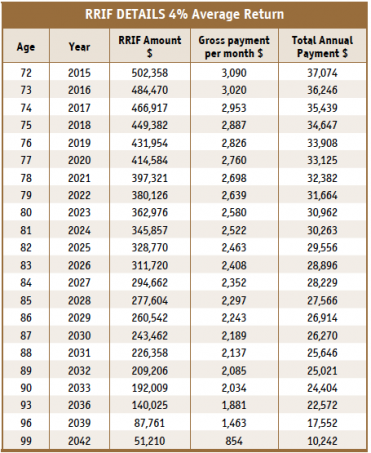Annuity Option For Your RRSP
 If you are approaching age 71, you will have until
If you are approaching age 71, you will have until
December 31 of that year to begin withdrawing an income or taking a lump sum from your registered retirement savings plan (RRSP). Cashing out your RRSP as a lump sum is hardly a good option since the amount you cash out is fully taxable to you after you have paid the initial withholding tax which is:
- 10% on the first $5,000
- 20% between $5,000-$15,000
- 30% more than $15,000
Since most retirees are reluctant to pay lump sum taxes on their retirement savings plans, they usually chose to draw a monthly income by converting their RRSP to a registered retirement income fund (RRIF) or an annuity. These two options allow them to spread out their fully-taxable RRSP retirement income every month or every year.
This article will discuss the much less talked about annuity option, and compare it to a RRIF. Here are some basic RRIF rules:
- RRIF investments continue to grow while sheltered from tax. The amount of RRIF withdrawn is taxed at your marginal tax rate.
- You will continue to decide where to invest your RRIF assets. A RRIF account can basically hold the same investments as your RRSP. The choices are endless.
- When you set up a RRIF account, at age 71, you will have a minimum mandatory payment that must be withdrawn each year.
- Currently, RRIF rules state in the year after you open your RRIF at age 71, you must withdraw a minimum of 7.38% of its value. The percentage withdrawal amount of your RRIF income increases as you get older.
- There is no maximum withdrawal amount. You can withdraw all of the funds in your RRIF at any time subject to tax.
Annuity Option
If you’re concerned about low interest rate RRIFs and if market volatility keeps you up at night, then consider an annuity. Compared to a RRIF, an annuity is a simple product. It is a specialized financial product provided by an insurance company that takes your RRSP assets and converts those assets into a retirement income for you over a fixed period of time or for the rest of your life. Once you choose to purchase an annuity there is no access to your capital. You are giving up your capital for a guaranteed income for life. Annuity income is based on several factors:
- the amount of money used to purchase the annuity;
- the type of life annuity purchased;
- current interest rates and present long-term bond rates;
- the age and gender of the annuitant;
- expense and mortality experience of the insurance company.
Although RRIFs are more flexible than registered annuities in terms of liquidity and investment choices, an annuity provides a steady stream of guaranteed income that never decreases and has no management fees. Annuities can create personal pension plans for those without pension plans.
Sales of life annuities and term certain annuities are increasing in Canada. According to the Life Insurance Marketing & Research Association (LIMRA) sales of annuities grew by over 23% in Canada in the first half of 2014, compared to 2013. LIMRA recorded annuity sales reaching over $400 million during that time.
Why Have Annuity Sales Increased In The Past Year?
Canadians are living longer. According to Statistics Canada a 65-year-old male can expect to live to age 85, while females can live to age 87. With a growing number expected to live into their 90s while others will reach the century mark, improved life expectancy creates a financial risk—the risk of outliving your savings. Since Canadians are living longer they need their retirement income to last longer.
If you do not make the correct choices when converting your RRSP to either a RRIF or an annuity, then you could possibly run out of money. Putting some of your RRSP into a life annuity may be a better choice than directing all of it into a RRIF. With the RRIF’s prescribed withdrawal schedule, the value of your RRIF may reduce rather quickly.
RRIF Versus Annuity
A proper comparison between the two products requires a look at the best annuity rate on the market for a joint-life annuity. Why joint-life annuity? If the primary annuitant dies, then the annuity income would continue to the surviving spouse. This compares well to a RRIF because when the RRIF owner dies, his spouse will receive the remaining balance of the RRIF due to the tax-free spousal roll-over provision. If there is no spouse than a single life annuity should be illustrated and compared for best annuity rates.
Below is a RRIF chart showing a $500,000 RRSP converted to a RRIF earning an average of 4% rate of return. Using a 71-year-old male for this example allows us to factor in the minimum withdrawal amount a person must withdraw out of the RRIF in order to meet Revenue Canada RRIF rules. In this example the RRIF income is to begin on January 1, 2015.
 The chart above shows the gross RRIF payment per month begins at $3,090, then reduces every year to $2,034 by age 90, using the minimum withdrawal RRIF rules. After age 90 the income continues to decrease every year until it reaches $854 per month at age 99.
The chart above shows the gross RRIF payment per month begins at $3,090, then reduces every year to $2,034 by age 90, using the minimum withdrawal RRIF rules. After age 90 the income continues to decrease every year until it reaches $854 per month at age 99.
Let’s compare the above RRIF income to a joint-life annuity purchased with the same $500,000 RRSP. After an annuity comparison analysis, I locate the best joint-life annuity rate for a male and female age 71. Presently, a highly-rated Canadian insurance company is offering the annuitant $2,839 per month or $34,068 per year for the rest of his life. 100% of the annuity income will continue to his spouse on the annuitant’s death.
Which One Do I Choose?
Clearly, the average income from the annuity is higher than the income from the RRIF and the annuity income never decreases. However, the RRIF has greater flexibility in terms of gaining access to your capital. There is no access to your capital when you purchase an annuity. This is what you are giving up for a higher income.
If you like the higher income of an annuity but also like the flexibility of a RRIF, then you can look at combining the two retirement income options. The question becomes, “How much of my RRSP should go to an annuity and how much should go to a RRIF?” There is no general rule but a minimum 25% of your RRSP portfolio should be considered for an annuity since it offers you a higher guaranteed income stream. Try to cover your basic expenses at retirement with an annuity. Include in your calculation the income you are receiving from CPP, OAS and other guaranteed retirement income such as pension plans. This should give you a good idea on how much of your RRSP funds can be left for your RRIF in case you have an emergency and require to withdraw some of your capital.
When it’s time to choose your RRSP retirement income options, creating a portfolio with a mix of both RRIFs and annuities makes sense. The annuity can be your guaranteed lifetime income product which allows your other retirement product, your RRIF, to provide you with investment growth opportunities and easier access to your money.
Rino Rancanelli, BSc. Financial Security Advisor, MRH Financial Services, Oakville, ON (416) 880-8552, racanelli@sympatico.ca. Rino is an independent agent selling life, critical illness, long-term care and disability insurance.

